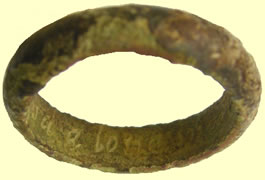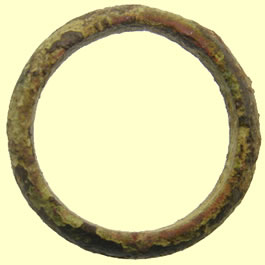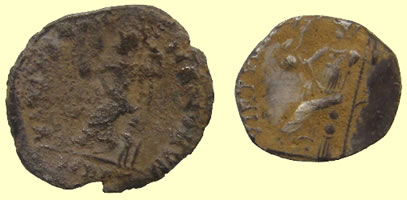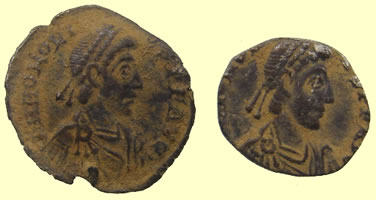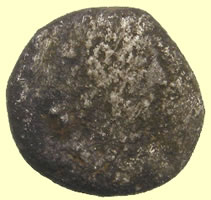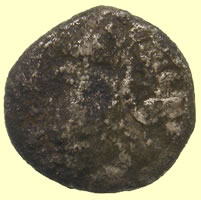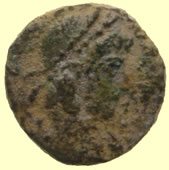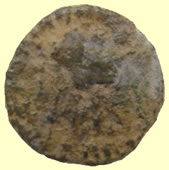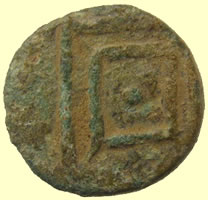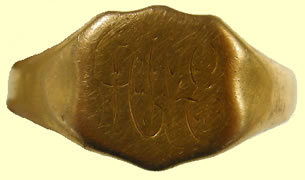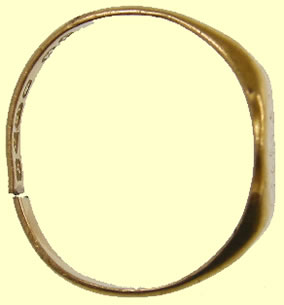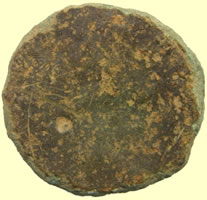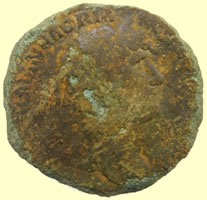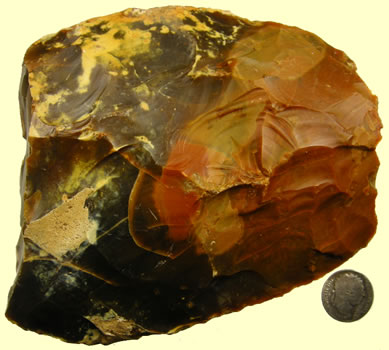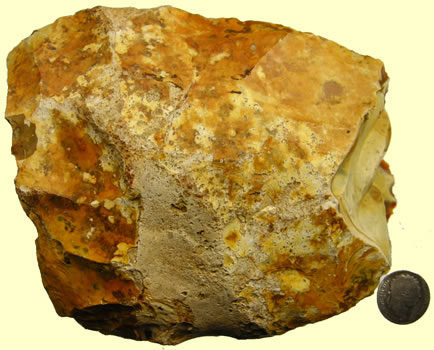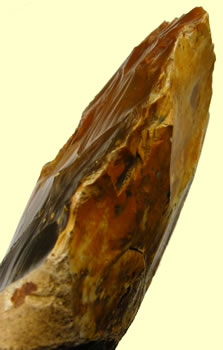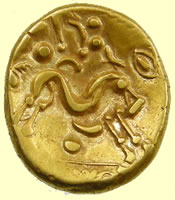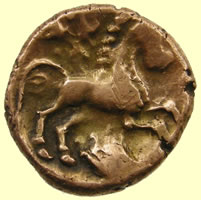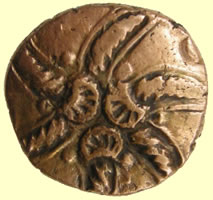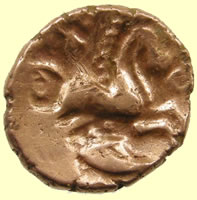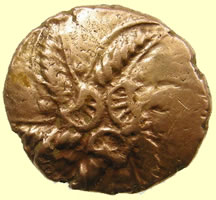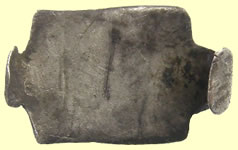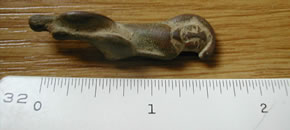

Metal detecting holidays in England with the World's most successful metal detecting club.
Twinned with Midwest Historical Research Society USA
2013 March find Page 2 |
This coin looked like it had a fresh break with the chunk missing when dug. Dropping it in lemon juice prior to cleaning gently is has fractures in two places. Time to test our goldsmiths repair skills again 825 - 845 Athelstan I of East Anglia, North 439 Obv ETHELSTAN in centre A Rev REX ANG Omega 1.16g, 18.53mm Sent to CCI for recording |
|||
 |
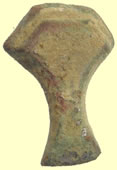 |
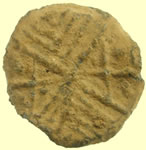 |
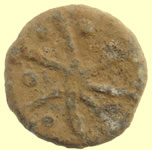 |
| 1500-1700 mount | 1500-1700 mount | 15thC lead token | 15thC lead token |
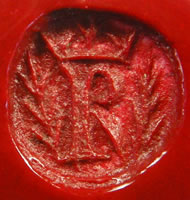 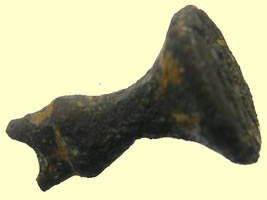 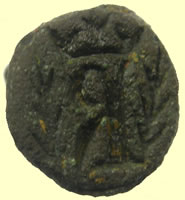 |
|||
13thC seal matrix Anonymous: letter R An initial with crown above, branches at the side, was a design that became incrreasingly common in the 15thC and was often used on a signet ring. The letter suggests it stood for the owners forename. Examples were used in 1424 by Edward Saddler, clerk. |
|||
 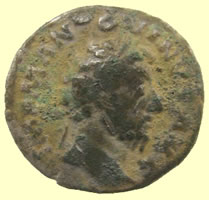 |
|||
Interesting find yesterday, is it silver, debased or washed ? Not attemping to clean it until I know it will not be damaged. - Mindy Roman silver coin sent to Mark Lehman for ID Can you see exposed copper on this one? I believe it is a standard (official issue) silver (at least 50-60% or so) denarius of Marcus Auelius (161-180) so you might want to check to be sure that it's not just profoundly tarnished and possibly cleanable silver. There is an entire class of cast (generally, rather than struck) denarii and a few earlier antoniniani which were made by impressing genuine coins in clay to make molds. They can be surprisingly close to the originals, particuarly as castings go, and when found in perfect condition may retain a very thin silvery outer layer, but generally appear to be strictly Æ. These are mostly found in the Balkans and the era in which they were commonly produced was from about 200-250 AD - at least the protoype coins from which the molds were made tend to be from that era - coins predominantly of the Severan dynasty. These are incorrectly referred to as "Limes Denarii" - and although this is a terrible name for them (it conflates them with the class of "Limes Falsa" undersized, struck contemporary copies of Julio-Claudian Æ from Britain and Northern Gaul - with which they share virtually no qualities other than both being contemporary copies) they have now been referred to by this term long enough that it has achieved a certain legitimacy and it would probably be impossible to convince the market in general to stop using this misnomer-name for them. These Balkan Æ denarii used to be quite scarce until the 1990's when huge quantities of coin began to reach western markets from the former "Iron Curtain" countries like Bulgaria, Romania, the countries of the former Yugoslavia, and the most south-western of the nations formely part of the Soviet Union like Ukraine. Now they are not exactly "common", but just about everyone has seen them in person now and most folks I know have at least a few of them sourced from lots of uncleaned coins alongside Roman Provincial and Constantinian-era material. I'm not saying this marcus Aurelius cannot be a contemporary copy, but unless you're certain it isn't silver, I'd assume it's a regular Mint of Rome product. For comparison, here's a pretty early (the prototype dates to 198 AD), so-called "Limes denarius" of Septimius Severus: This probably would have been at least silvery-colored originally, but by the time we see them, they almost always appear to be Æ, like this one. There is also a class of struck fourrees from this same general era - often mistaken for official issues, they are "silver-washed" (I explained recently why this is also a misnomer but won't repeat it here) at a time before the silvering process had been used on any official Roman coins - that practice didn't occur until the 260's under Gallienus. This "plated" Julia Maesa denarius can be seen obviously not to be an official denarius from a standpoint of style and workmanship as well as fabric, but unlike the fourrees of the 1st century BC & AD, the Æ core is not wrapped in a silver foil - rather it appears to have been created by surface enrichment: It should look like this: Let me know what alloy the Marcus Aurelius turns out to be - if it is a Balkan copy, it would be the earliest example of the type I've ever seen. Mark
|
|||
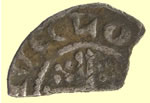  |
 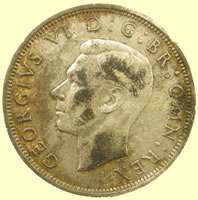 |
||
1189 John hammered silver half penny Obv HENRICVS REX Rev **MVEL O ** Moneyer Samvel of Canterbury mint |
1946 George VI milled silver half crown (30 pencxe) | ||
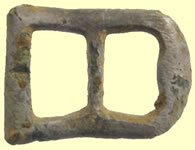 |
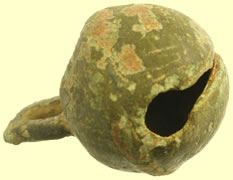 |
 |
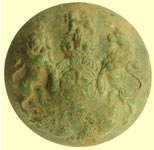 |
Cast asymmetrical buckle frame with a narrowed pin bar Circa AD 1575 -1700 |
18thC crotal bell | Royal Artillery button | 1890 Army general service button |
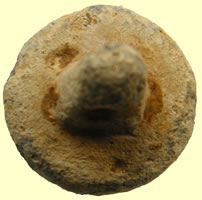 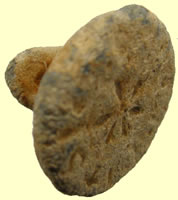 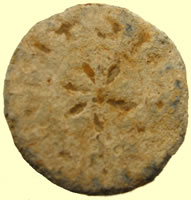 |
|||
| First 13thC pasture seal type seal matrix I have seen with this type of suspension loop | |||
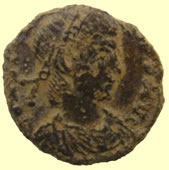 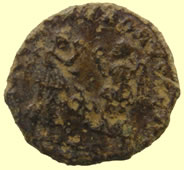 |
 |
||
| 4thC Roman bronze coin sent for ID | 18thC toy cannon | ||
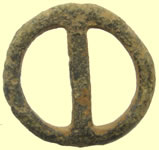 |
 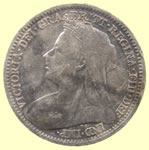 |
||
| Medieval annular buckle | 1900 Victoria milled silver 3 pence | ||
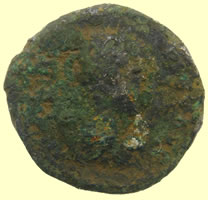 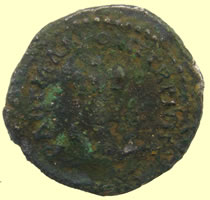 |
|||
Roman silver coin - sent for ID before cooking - Ron The only place I can find the reverse legend (which is about all that I can make out on this piece at this point) is on denarii of Septimius Severus and Caracalla. (c. 193-217) It reads: PART MAX PONT TR P IIII - it should show 2 captives seated at the foot of a trophy. So yes, this should definitely be pretty good silver (unless you have some reason to suspect a fourree, it should be better than 50% at any rate) and a candidate for cooking. When some of the crud on the obverse falls away, I should be able to tell you whether this belongs to father (Sept Sev) or son (Caracalla) - or someone else. This is also interesting in that you have shown me very little material from the Severan Dynasty overall - it's made itself pretty obvious by its near complete absence from the record of coin-types you've found, while Severan coins, in general, are not at all scarce anywhere else. Mark |
|||
11.95g, 26.59mm
|
|||
Very crisp large Roman copper coin sent for ID I can perhaps give you a little more detail on this one later this evening, but I can tell you quickly that it's a follis of Galerius as Caesar - Diocletian's 2nd in command in the Eastern half of the Empire in the first Tetrarchy. Galerius was Caesar from 293-305. This appears to be one of the earlier, larger folles (they're considered billon, BTW, not "copper", per-se. ) it's a GENIO POPVLI ROMANI, the most common reverse type. I can't make out the mint mark at first glance, but perhaps I can tease it out with a little image manipulation. Mark I finally figured it out - RIC does list an officina designation of delta-epsilon for these folles, (a different way of indicating officina 9. Theta, the Greek number 9, was considered unlucky by the superstitious Romans and so 9 was often written as delta-epsilon when Romans used Greek numerals) but the text doesn't note that the two letters are split between the two fields. However, there is a photo in the plates section showing a different type of follis, but with an "officina 9" designation represented by delta and epsilon divided between the left and right fields. So, this is definitely from the Mint at Antioch - if you can determine with the coin in-hand whether the obverse legend is: GAL VAL MAXIMIANVS NOB CAES then we would be able to be certain whether this is Galerius as Caesar or Maximinus II as Caesar. I think it's Maximian (the 1st one) but "Murphy's Law of Coin Legends" states: In the case of similar legends, the letters most likely to be vague or ambiguous are the ones most necessary to determine which of the possibilities it is." Galerius' dates as Caesar are 293-305. Maximinus II's dates as Caesar are 305-308. Mark |
|||
 |
 |
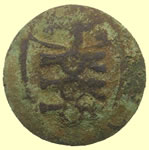 |
|
| Huge cow bell and crotal bell | 18thC Royal Navy silver button | 18thC Royal Artillery button | |
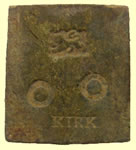 |
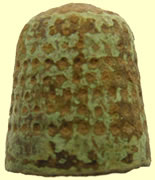 |
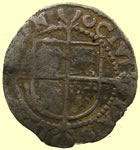 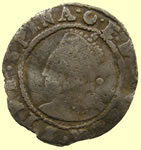 |
|
| 18thC bullion weight - Lion mark | 15thC thimble | 1587-9 Elizabeth 1st hammered silver penny - Crescent mint mark | |
|
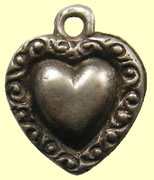 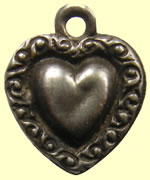 |
||
| Medieval strap end | Victorian silver locket | ||
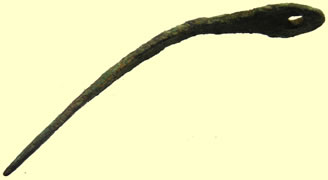 |
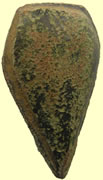 |
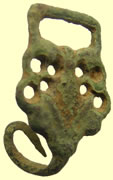 |
|
| Medieval implement pendant | 1500-1700 mount | 16thC Tudor clothing fastener | |
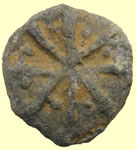 |
|
||
| 15thC lead token | Medieval decorated bronze ring | ||
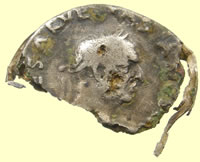 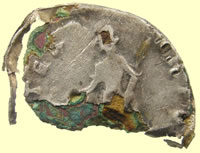 |
|||
Roman silver forgery - sent for ID Great relic as it shows clearly the two sheet of silver over a bronze core Now that is some real "core exposure". This is actually quite the "exploded diagram" of a textbook 1st century fourree. The copper core was wrapped in a significantly thick silver foil with a layer of flux applied under the silver which was then "soldered" to the core by annealing. Usually, you only see holes in the foil -"core exposures", although I have occasionally seen an empty silver shell (or approxiamtely 90% or one, at least) from which the copper core has been completely corroded away and lost. This appears to copy a denarius of Vespasian, although it could as easily be meant to be Titus - the beginning and end of the legend having been lost makes it impossible to be sure, but the portrait favors Vespasian. The reverse seems to be COS ITER TR POT with Aequitas standing left, the scales she holds are lost just below the break in the silver. This reverse is an exclusively Vespasian type, but it's not at all unusual for fourrees to mule obverses with "inappropriate" reverses. In fact, I used to own a fourree of an Otho denarius (see photo below) with this same Aequitas COS ITER TR POT reverse, so this doesn't prove it's not Titus either. Vespasian's 2nd consulship began in 70 AD, so this piece can't date to much later than 80 AD without the reverse being so anachronistic as to have caused suspicion. Mark |
|||
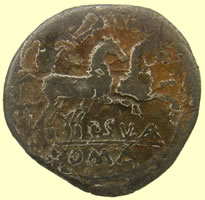 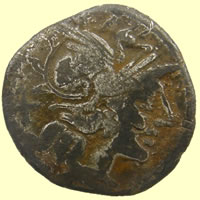 |
|||
151BC Roman republican silver coin sent for ID - 2nd oldest coin ever found by the our club This is a denarius of P. Cornelius Sulla (same family as the famous dictator of the next century, but a different Publius Cornelius Sulla) dating to 151 BC - Mark |
|||
 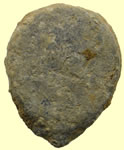 |
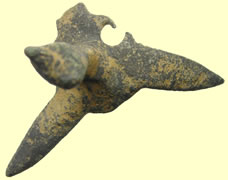 |
||
| 17thc lead bale seal | Medieval prick spur | ||
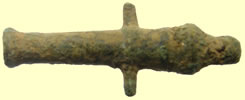 |
 |
  |
|
| 18thC toy cannon | Medieval hanging pendant | 1247 Henry III hammered silver voided half penny Rev ** ORb/PhI/*** Moneyer Philip of Northampton |
|
Not a 70 BC Celtic Morini boat tree qtr gold stater as I first thought - rare North Thames type 1.48g, 10.58mm This coin is an important find because although it's a type based on Gallo-Belgic D Boat Tree quarters it's an early British copy, ABC 2454, from the same dies as the one illustrated in the book. Although ABC says it's excessively rare there are actually around 20 known, but there are very few reliable findspots and this one helps to confirm it's a North Thames type. I've recorded it as 13.0002 (got some new numbers through at last). All the best John |
|||
1413 Henry V hammered silver groat - scare 'scowling bust' type - im Pierced cross with pellet at centre - Class B 9 arches to tressure - Mullet on right of breast - Double satire stops Obv HENRIC DI GRA REX ANGLE Z FRANC Rev CIVI/TAS/LON/DON - London mint
|
|||
Very unusal coin weight not in my ref books - looks continental - needs more research |
|||
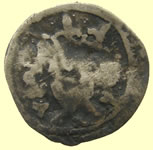 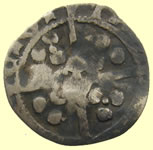 |
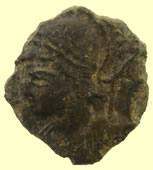 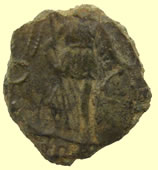 |
||
1461- 1470 Edward IV hammered silver penny Trefoils by neck - quatrefoil in centre of reverse cross Extra pellet (smaller) in two quadrants Rev CIVI/TAS/ ** - Durham mint |
4thC Roman bronze coin sent for ID That's a CONSTANTINOPOLIS city commemorative, c. 330-337. This one is from the mint at Trier and interesting because of the symbol in the field to the left of Victory - the ones with symbols in the field are quite uncommon in the series, overall. Not so much so from Trier specifically, but generally the ones with symbols you don't see every day. Mark |
||
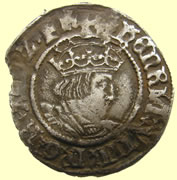 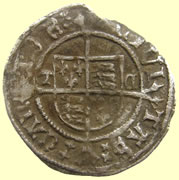 |
 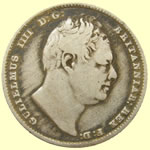 |
||
1526 -1544 Henry VIII hammered silver half groat - 2nd coinage TC by shield Archbishop Thomas Cranmer Rev CIVI/TAS/CAN/TOR - Canterbury mint |
1834 William IV milled silver sixpence | ||
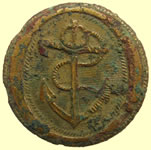 |
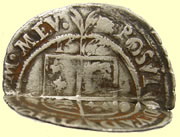 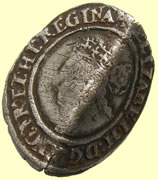 |
||
RN Capt / Commander - 1787 RN Lieutenant - 1787 |
1566 Elizabeth 1st hammered silver sixpence - Lion mint mark | ||
Medieval badges Ref Mitchiner p244 939 - 941
|
|||
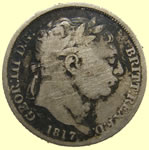 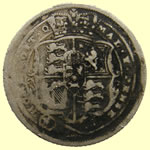 |
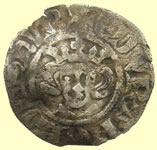 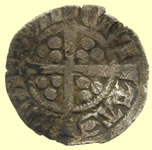 |
||
| 1817 George III milled silver sixpence | 1344 Edward III hammered silver penny - Florin issue - Cross 3 Obv EDWR ANGL DNS HYB Rev CIV/TAS/LON/DON- London mint |
||
 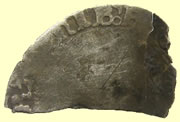 |
  |
||
| 1554 Mary hammered silver groat | 1180 Henry II hammered silver short cross half penny Rev *AVL.ON ** - Moneyer Ravl - Class 1 |
||
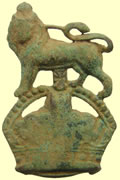 |
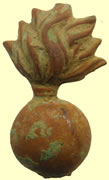 |
 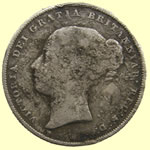 |
|
| Army badge | Army badge | 1853 Victoria milled silver sixpence | |
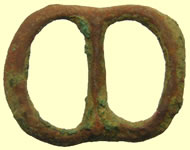 |
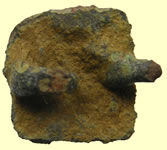 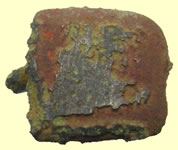 |
||
Post Medieval cast copper alloy single loop buckle frame. 1500-1650 AD |
1500-1700 mount | ||
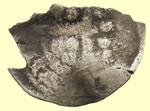 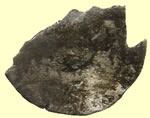 |
  |
||
Medieval hammered silver penny Obv ** REX** CIVI/TAS type |
1272 Edward 1st hammered silver penny Obv ***** DNS HYB Rev CIVI/TAS/LON/DON- London mint |
||
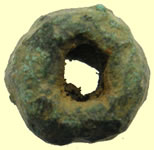 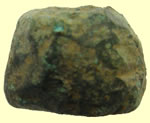 |
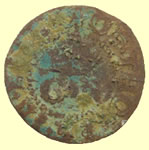 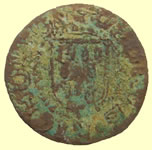 |
||
| Iron Age bead | 17thC Nicolas George , Grocers of Thorpe Le Soken Essex hammered copper trade farthing | ||
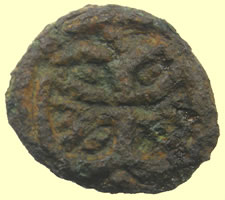 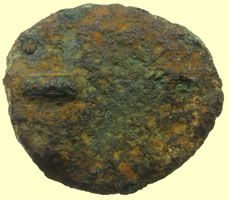 |
|||
| What I thought was a Roman disc brooch is now cleaned up and the design looks more Anglo Saxon type- one for the museum experts | |||
Brilliant relic - Our first ever non gold 17thC copper posy ring with full inscription 'In god a love wee one' which means 'In god a love we won'
|
|||
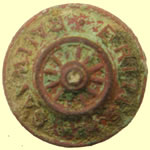 |
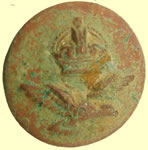 |
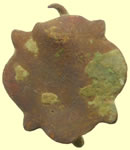 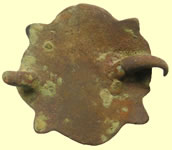 |
|
| Britiah Railways button | WWII RAF buttons | 1600-1700 AD copper-alloy cast mount. The mount is quatrefoil in shape with a cusp in each angle. | |
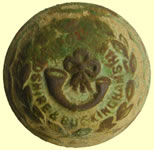 |
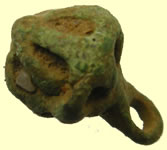 |
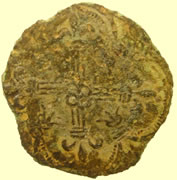 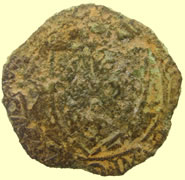 |
|
1881 The Oxfordshire and Buckinghamshire Light Infantry button |
16thC Tudor button | French copper- alloy Jeton 1380AD Obv Shield of France | |
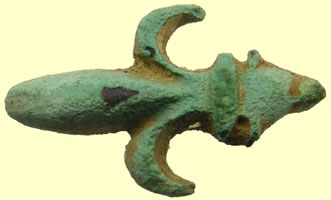 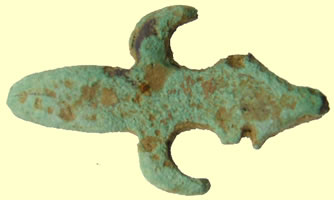 |
|||
| Amazing little medieval fleur de lis mount with some gilding remaining and diamond shaped red enamel inlay | |||
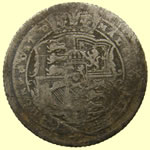 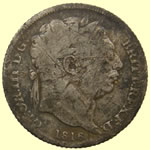 |
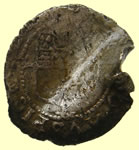 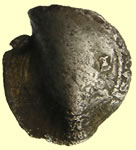 |
||
| 1816 George III milled silver sixpence | 1634 Charles 1st hammered silver penny | ||
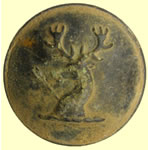 |
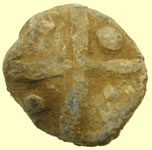 |
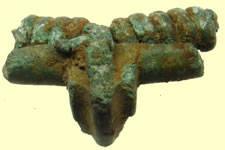 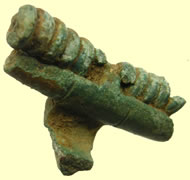 |
|
| 19thC livery button | 15thC lead token - type 2 | Great relic showing spring intact on a 1stC Roman fibular brooch | |
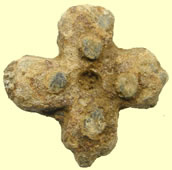 |
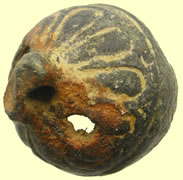 |
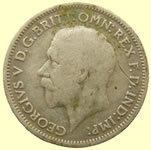  |
|
| Medieval lead cross mount | 17thC crotal bell | 1935 George V milled silver sixpence | |
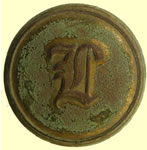 |
 |
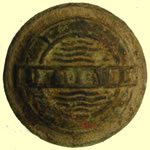 |
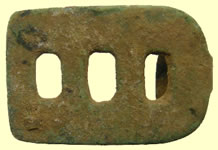 |
| 19thC livery button | Post Office button | Shipping line button ? | 18thC clog fastener |
 |
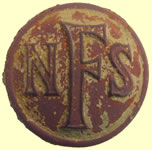 |
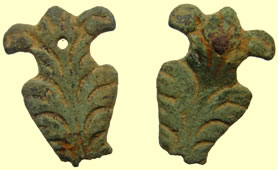 |
|
| Glascow Corporation Transport button | National Fire Service button | 2 - 17thC sword hanger fittings | |
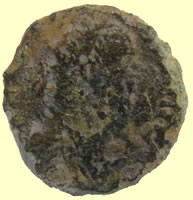 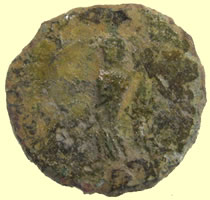 |
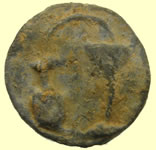 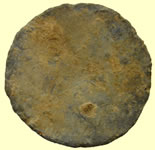 |
||
Debased silver Roman coin sent for ID - Ed Unless I have some sort of brainstorm based on the portrait - which as you can see at this point has degenerated into a pretty generic radiate head with very few distingiushing or distinguishable features - I'm afraid I'll have to be satified with saying this belongs to the period 265-285, after the increasing official debasement began to require a layer (however produced) of "silvering" over a very base billon coin of an alloy undistinguishable without significant laboratory equipment from "bronze", and before the reforms of Diocletian. There are two clear letters on the obverse, the "...VG" of the "AVG" with which virtually all imperial obverse/titlature legends end. The reverse type is a fairly generic standing personification, but from the posture which suggests the right hand is raised holding an object and the suggestion of a transverse scepter across her midsection, I'd have to say it is most likely Pax - which, as you may know, is virtually the "default" reverse for antoniniani of the period. No one issuing ants in this period failed to strike a PAX AVG, and this type was almost always the most common type struck for each ruler. I'll keep this email for a bit and see if further glances at the portrait make it begin to resemble anyone in particular. Mark |
16thC Elizabethan illegal public house lead token | ||
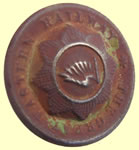 |
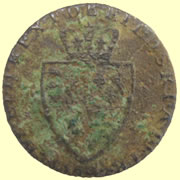 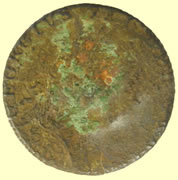 |
||
| The Great Eastern Railways button | 18thC George III gold half guinea gaming token | ||
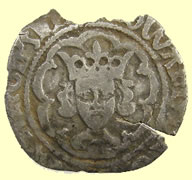 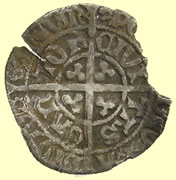 |
  |
||
1464 Edward IV hammered silver half groat - im Rose Obv EDWARD DI GRA REX ANGL Z FR Rev CIVI/TAS/CAN/TOR |
1247 Henry III hammered silver voided half penny Rev /NIC/OLE/ Moneyer Nicole |
||
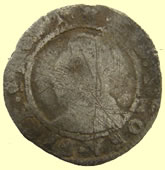 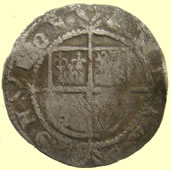 |
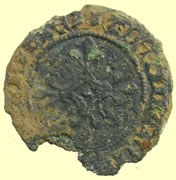 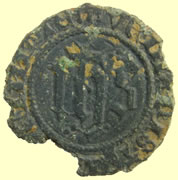 |
||
| 1560-1 Elizabeth hammered silver half groat - Martlett mint mark | circa 1447 Charles VII Jetton with IHS Letters IHS in gothic script acorss field with upright stroke of H crossed AVE IIIARI STEELA DEI IIIATER Rev Double stranded arcuate cross fleuretty with pellet at centre |
||
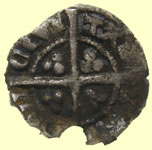 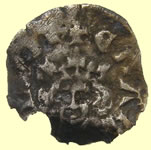 |
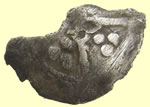 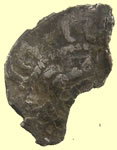 |
||
1299-1300 Edward 1st hammered silver farthing Rev ER ANGL D N Obv CIVI/TAS/LON/DON - London mint |
Medieval hammered silver penny quatrefoil with pellet in reverse cross - York mint |
||
1.01g,16.44mm & 1.0g,13.59mm Amazing find - the before and after clipped Roman silver hoard coins that now weigh the same as the larger one is really thin. Ill Tim found both together I doubt rather seriously that any clipping of Æ coins went on in the later Roman Empire - it just wasn't worth it any more than trimming a sliver of paper off a banknote would be. Still, many folks insist they have "clipped" examples of Æ coins. What they typically have is an example of a smaller denomination struck with the dies intended for a larger denomination or simply on skimpy flans - so skimpy that the coins so produced wind up so much smaller that they may be mistaken for a different denomination. These however, seem to be silver. So, rather than some enterprising merchant shaving slivers of silver from coins passing through his hands, what you have here is 2 different denominations representing 2 different time-frames - and the smaller of the two was created officially rather than serruptitiously. The smaller piece is an example of what happened to much of the circulating stock of siliquae after the Romans packed-up and left - it was officially cut down to the size and approximate weight of a Saxon Sceat. I'm not 100% certain that the smaller one is also of Honorius, despite the similarity in portrait. Arcadius, Theodosius II and Constantine III struck the exact same reverse and there was significant overlap in their years of rule. I can't be completely certain from the little seriphs which are all that remain of the letters, but I would hazard a guess that it is Honorius. Theodosius can often be mistaken for Honorius and vice-versa due to the O's. Mark
1.44g, 13.25mm - Covered with thick horn silver crust Chicgao Ron found a 3rd that is really thick with horn silver crust.
Another Roman bronze coin found in the hoard area by Chicago Ron - reported to museum As I wrote a few minutes ago in an earlier email, Æ coins were not subject to random clipping - or it it ever occurred, the practice was unusual and not widespread. I am not, however, completely certain that it is a Fel Temp - it's tough to tell in this state of cleanliness. Mark Honorius - 393-423 AD addendum to previous hoard find with treasure number below Treasure number of 2012 T729 Late fourth century siliquae found in Britain, sometimes in large hoards, are often clipped quite severely. This phenomenon is not known from elsewhere within the empire, but it does occur in areas outside it. It would therefore seem that these clipped silver coins belong, in Britain, to the period after the Roman withdrawal. The clipping of these earlier coins perhaps brought them into line with the weight of fifth century Gallic coins. Some citizens no doubt still owned quantities of solidi for wealth storage, but widespread coin use in Britain probably ceased by c. AD430. A sixth century site, Castle Dore, is completely coinless, and the next coinage to appear in Britain was that of the Germanic settlers in the seventh century. But that is another story. The last known appeal by Britons to Rome was in AD443, according to the Anglo Saxon Chronicle. It was unsuccessful, but the Britons who fought the battle of Mons Badonicus, c. AD500, probably still thought they were defending a basically Romano-British, Christian, way of life against the pagan Saxon interlopers. In this, of course, they eventually failed, but that too is another story.
|
|||
This is one wierd ancient coin - Looks kind of Saxon rev, is it Roman but could be a Celtic ? It has a right facing bust with pointy nosed Saxon features and beard. Crown like a Roman. Rev looks kind of Saxon too with double squares. Could be a wierd Potin ? It is probably a Roman bronze so I sent it off to all the Celtic, Roman and Saxon experts to be sure. 1.96g, 14.35mm Whether or not it is to be attributed to the Saxons, this appears to be one of the class of coins generally referred to as "Barbarous Radiates". The square pattern on the reverse is an interpretation (I think) of the altar reverse on posthumous coins of Claudius Gothicus. Like a game of "telephone" or "whisper down the lane", common or popular coin designs were passed along through the years, were changed and became increasingly stylized - like the Celtic staters in imitation of tetradrachmae of Philip II of Macedon, over 250 years earlier and a thousand miles away - but by the time we see them in Gaul and Britain, all that remains of the portrait of Zeus is the stylized representation of the hairband and the horse has become an "exploded diagram".
|
|||
1911 Mans gold signet 'love' ring - Inscribed inside D.K.G - external JCIE 18 carat Chester hall mark Maker JH 21.3mm dia,4.86g |
|||
2ndC Hadrian Roman bronze ? sent for ID 31.53mm 13.79g At this size, this is obviously a sestertius of Hadrian - as you obviously could tell for yourself from the large fragment of the obverse legend. Hadrian you might have heard of - as I understand it, he built a wall across the country to keep haggis out of London, or some such. Hadrian became emperor on the death of Trajan in 117 and ruled until 138. Unfortunately, the reverse is so featureless on this specimen that I can't even hazard a guess as to what the reverse type might have been. Mark |
|||
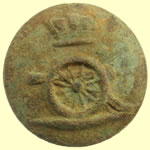 |
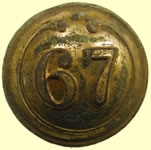 |
|
|
Royal Horse Artillery Generic Issue Officer & O/R's - 1873-1901 |
French Infantry Button
67th Line Regiment Circa 1803-1814
|
1stC Celtic cosmetic wode grinder | |
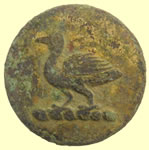 |
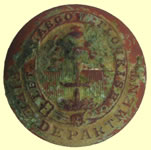 |
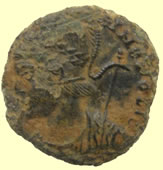 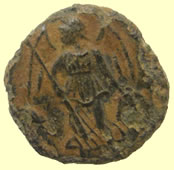 |
|
| 19thC livery button | 20thC Glascow fire department button 'Let Glascow flourish' |
Very crisp 4thC Roman bronze coin sent for ID This is a Constantinopolis - city commemorative for Constantinople - c 330-337. I know I sent you a write-up on city commemoratives within the last couple weeks. I see none of the exergual mint mark is left on this specimen, but the symbol in the left reverse field leads me to believe this was probably a product of the mint at Trier which used fieldmarks on city commemoratives more often than any other mint. Mark |
|
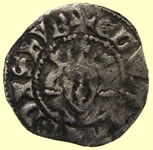 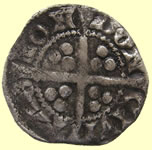 |
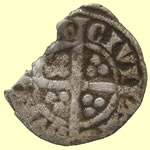 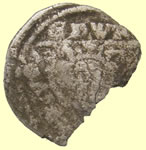 |
||
1344 Edward III hammered silver penny - Florin issue - Cross 3 Obv EDWAR ANGL DNS HYB Rev CIV/TAS/LON/DON- London mint |
1279-1284 Irish Edward Ist hammered silver penny Rev CIVI/TAS/DUB/LINE -City of Dublin |
||
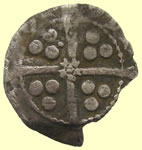 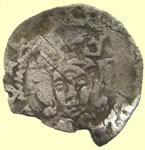 |
 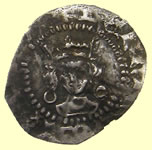 |
||
1461- 70 Edward IV hammered silver penny - Class IV, Rose in centre of reverse cross im Cross - Extra pellet in one quadrent of reverse cross Obv EDWARD +REX+ANGLIE Z FR Durham mint |
1422-61 Henry VI hammered silver halfpenny - 1st reign Annulet Issue - Annulets by neck and reverse with annulets in VIL and CAL qtrs Obv +hENRIC REX ANGL Rev VIL/LA/CAL/IS - Calais mint |
||
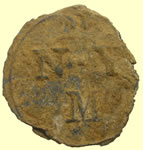 |
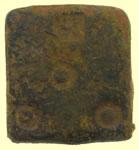 |
 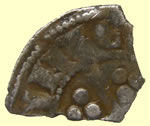 |
|
| Revolutionary Wars New York Militia button | 18thC bullion weight - Lion mark | 1272 Edward 1st hammered silver farthing CIVI/TAS/LON/DON - London mint |
|
 |
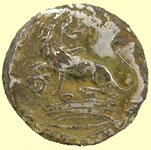 |
 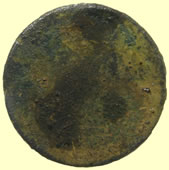 |
|
| Medieval pin head | 19thC livery button | 1826 Swedish billion silver coin | |
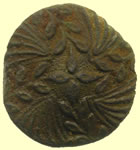 |
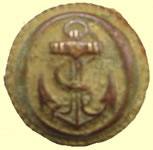 |
 |
|
| Georgian button | WWII German Navy Kriegsmarine Button |
Tiny Georgian decorated silver button | |
113.57mm Long x 105.72 mm W
|
|||
The biggest 11,000 BC Stone Age battle axe I have ever seen, that is a George III sixpence below to show you some idea of the scale of this find. Monster find |
|||
50 BC Gallo Belgic full Celtic gold stater - sent to CCI for recording and potential hoard coin 6.24g, 18.72mm A nice uniface stater, this is Scheers class 2, probably struck around 57-56 BC and one of the few Celtic coins that can be dated with some accuracy. I've recorded it as 13.0004.
All the best |
|||
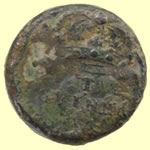 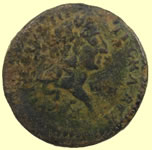 |
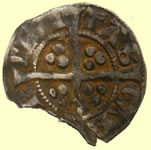 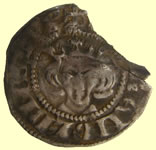 |
||
1696 William III gold 1 guinea coin weight Obv William bust Rev CROWN 1 GUINEA |
1272 Edward Ist hammered silver penny - Cross potent Obv *** R ANGL DNS HYB Rev CIV/TAS/CAN/TOR- Canterbury mint |
||
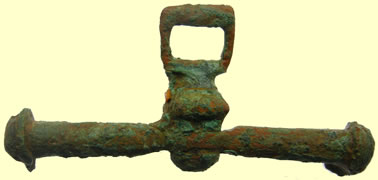 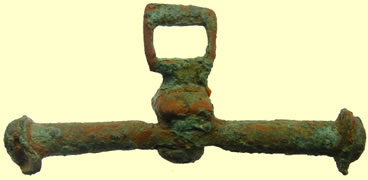 |
|||
| Medieval purse bar; Cast copper alloy purse bar, dating to the late 15th century. | |||
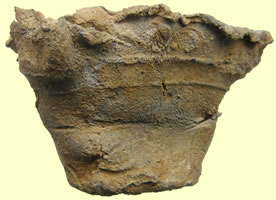 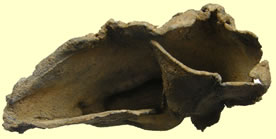 |
|||
| A decorated lead bird feeder of probable Late Medieval to post-Medieval date | |||
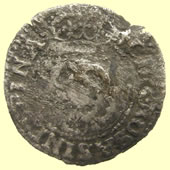 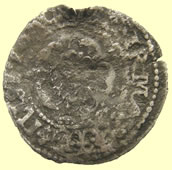 |
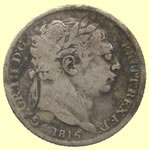 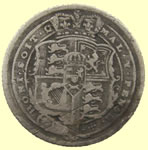 |
||
| 1604 James 1st hammered silver half groat | 1816 George III milled silver sixpence | ||
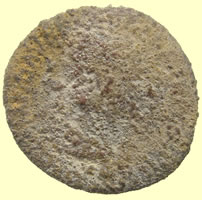 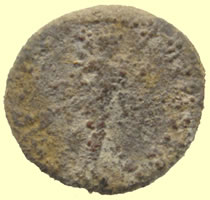 |
|||
| 2ndC Roman silver coin - cooking to remove horn silver crust | |||
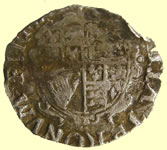 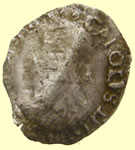 |
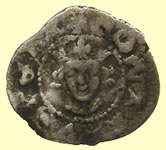 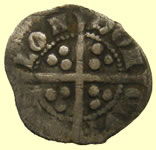 |
||
1641-3 Charles 1st hammered silver penny - mintmark 2 dots |
1285/6 Edward 1st hammered silver farthing - new issue inner circle both sides - Type 28 Oval flan Rev EDWARDVS REX Rev CIVI/TAS/LON/DON - London mint |
||
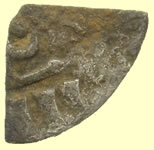 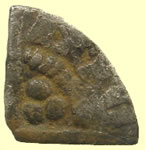 |
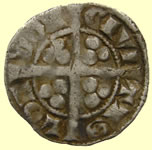 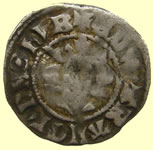 |
||
| 1247 Henry III hammered silver voided long cross farthing | 1344 Edward III hammered silver penny - Florin issue - Cross 3 Obv EDWAR ANGL DNS HYB Rev CIV/TAS/LON/DON- London mint |
||
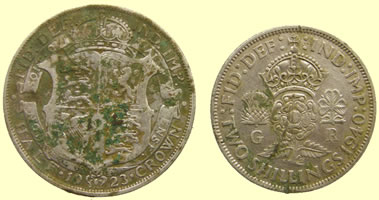 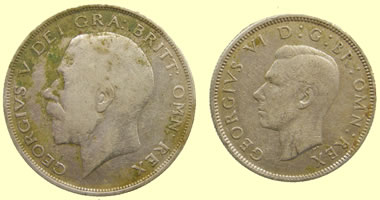 |
|||
| 1923 George V milled silver half crown (30 pence) and a 1940 George VI milled silver Florin (24 pence) coins for size comparison | |||
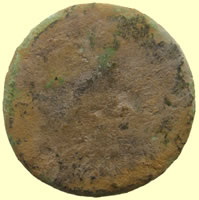 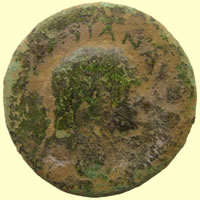 |
 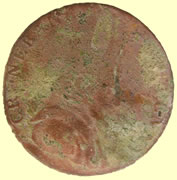 |
||
2ndC Roman bronze coin sent for ID Because of the "...SIAN..." we can clearly see from 11:00-1:00 on the obverse we might think at 1st glance to identify it as Vespasian. Actually, this does not immediately identify this as a sestertius of Vespasian. Most of Titus' coins - and therefore his coin legends - belong to the decade during which he was Caesar, rather than his fairly brief 2+ years as Augustus. Just about all of those coins as Caesar name Titus in terms of his relationship as Caesar to his father, Vespasian, as Augsutus. So at 2nd glance, we'd have reason to think it could as easily be Titus as Vespasian. However, on closer inspection, you can just make out "...AVG..." immediately after '...SIAN..." and as it turns out, only Vespasian's coins place AVG directly after his name when it's in this form (VESPASIAN rather than VESP or VESPASIANVS). So it actually is a Sestertius of Vesapsian, 69-79 AD. The whole obverse legend would, if we could see it, most probably read: IMP CAES VESPASIAN AVG COS III based on the location and spacing of the letters which are clearly visible. Mark |
Cronebane (Wicklow) copper Conder halfpenny token dated 1789. Obverse: Bust of Bishop Blaze with crook to right: "CRONEBANE HALFPENNY". Reverse: Shield of arms with a windlass crest: "ASSOCIATED IRISH MINE COMPANY 1789". Edge inscription: "PAYABLE AT CRONEBANE LODGE OR IN DUBLIN . X | ||
 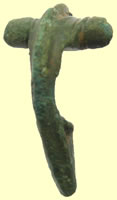 |
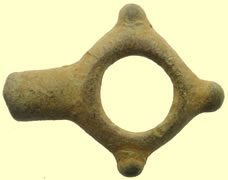  |
||
| 2ndC Roman fibular brooch | C10thC Saxon harness cheek piece | ||
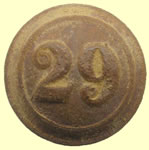 |
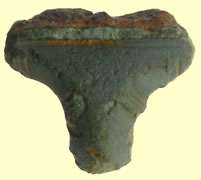 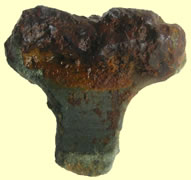 |
||
| German 29th Regiment | 2nd C Roman fibular brooch | ||
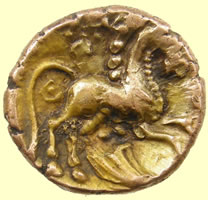 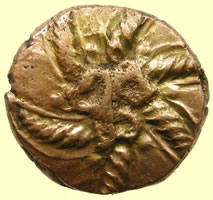 |
|||
Addedomarus 45BC Celtic gold full stater - reported as potential hoard to museum 17.43mm,5.51g CCI 13.0056 |
|||
Addedomarus 45BC Celtic gold full stater - sent to CCI for recording & reported as potential hoard to museum 17.63mm,5.48g CCI 13.0057 |
|||
Addedomarus 45BC Celtic gold full stater - sent to CCI for recording 18.27mm, 5.47g CCI 13.0055 |
|||
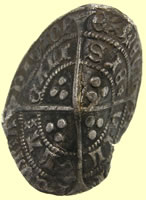 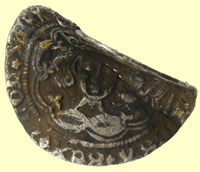 |
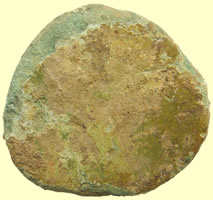 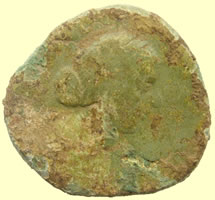 |
||
1427-30 Henry VI hammered silver groat - Rosette Mascle issue- Inital mark incurved pierced cross - rosettes and mascles in obverse legend obv HENRIC DI GRA REX ANGLIE Z FRANCE Rev inner VILLA CASTISIE - Calais mint Rev outer - POSVI DEVM ADIVTORE MEVM
3.51g, 27.07mm |
2ndC Roman bronze coin sent for ID Because of the "...SIAN..." we can clearly see from 11:00-1:00 on the obverse we might think at 1st glance to identify it as Vespasian. Actually, this does not immediately identify this as a sestertius of Vespasian. Most of Titus' coins - and therefore his coin legends - belong to the decade during which he was Caesar, rather than his fairly brief 2+ years as Augustus. Just about all of those coins as Caesar name Titus in terms of his relationship as Caesar to his father, Vespasian, as Augsutus. So at 2nd glance, we'd have reason to think it could as easily be Titus as Vespasian. However, on closer inspection, you can just make out "...AVG..." immediately after '...SIAN..." and as it turns out, only Vespasian's coins place AVG directly after his name when it's in this form (VESPASIAN rather than VESP or VESPASIANVS). So it actually is a Sestertius of Vesapsian, 69-79 AD. The whole obverse legend would, if we could see it, most probably read: IMP CAES VESPASIAN AVG COS III based on the location and spacing of the letters which are clearly visible. Mark |
||
 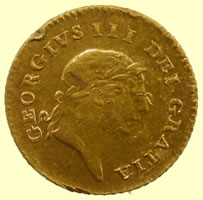 |
|||
1809 George III third gold guinea - 7th laur.head. 2.83g, 17.05mm |
|||
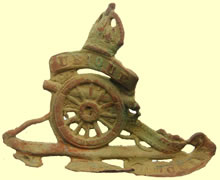 |
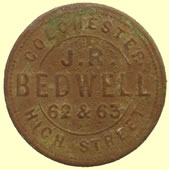  |
||||||||
| WWII Royal artillery badge | 19thC J.R Bedwell of Colchester token | ||||||||
 |
 |
 |
|||||||
| 16thC Tudor button | Victorian trade weight - Crown V cipher | 15thC casket key | |||||||
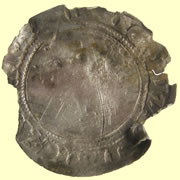 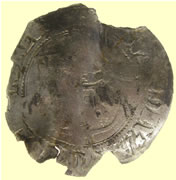 |
 |
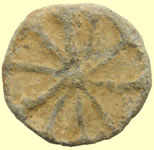 |
|||||||
| Interesting Elizabeth 1st hammered silver sixpence with the same 'thines's as a Mary groat - this is probably an early period Elizabeth 1st groat before it changed to a sixpence during her reign | 15thC lead token | 15thC lead token | |||||||
  |
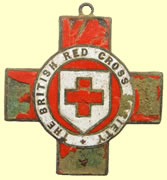 |
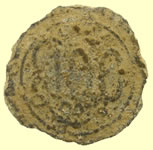 |
|||||||
| 1247 Henry III hammered silver voided long cross farthing | The Red cross society enamelled badge | 18thC 100th Regiment of foot button | |||||||
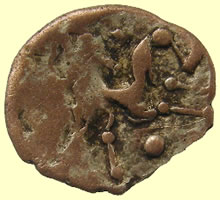 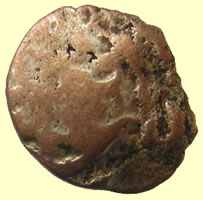 |
|||||||||
Trinovantes British G “Clacton” quarter, Hobbs 192 Celtic gold 1/4 stater 50BC - - sent to CCI for recording & reported as potential hoard to museum Chris Rudd 23.41 Clacton de Jersey - Classed as scarce 1.28g,14.25mm CCI 13.0053 |
|||||||||
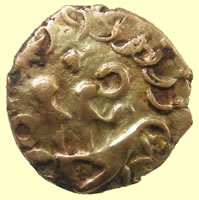 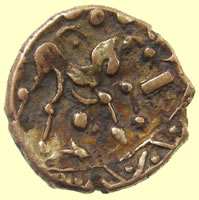 |
|||||||||
Trinovantes British G “Clacton” quarter, Hobbs 192 Celtic gold 1/4 stater 50BC - - sent to CCI for recording & reported as potential hoard to museum Chris Rudd 23.41 Clacton de Jersey - Classed as scarce 1.41g, 11.93mm CCI 13.0054 |
|||||||||
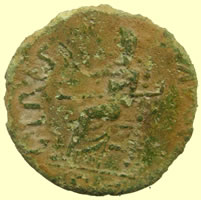 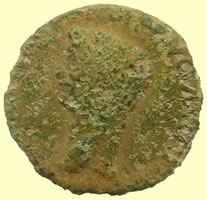 |
|||||||||
2ndC Roman bronze coin sent for ID
This is actually a dupondius, but being from Claudius, 41-54 AD, it lacks the familiar radiate crown (introduced by Nero) which served to distinguish dupondii from asses and sestertii, and is of a larger diameter than the more commonly encountered 2nd or 3rd century dupondii would typically be. This is the CERES AVGVSTA type - like this -
Ceres (the allegorical personification of grain, ergo the Roman civilization) is seated left holding a bunch of grain-ears in her right hand and a long torch transversely in the crook of her left arm. Mark |
|||||||||
 |
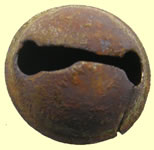 |
  |
|||||||
| 1720-1790 Boot or Garter buckles | Georgian horse harness bell | 1634 Charles 1st hammered copper rose farthing | |||||||
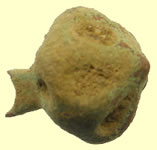 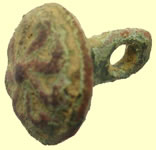 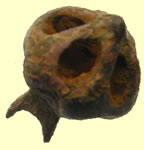 |
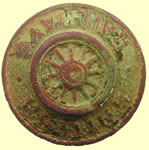 |
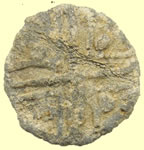 |
|||||||
| 3- 16thC Tudor buttons | British railways button | 15thC lead toekn - type 2 voided long cross and pellets | |||||||
  |
|
||||||||
| 1946 George V milled silver sixpence | 18thC decorated silver clog fastener | ||||||||
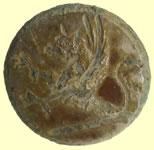 |
 |
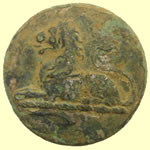 |
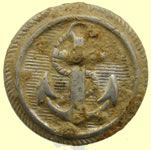 |
||||||
| 19thC livery button | RN Master - 1807-1825 |
19thC livery button | WWII German Navy Kriegsmarine Button |
||||||
 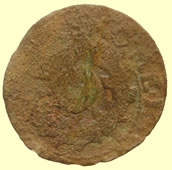 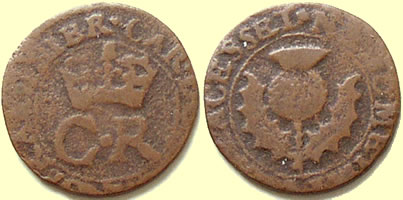 |
|||||||||
Facinating hammered copper coin -with Scottish Thisle on rev. Charles I (1625-1649) copper turner or half groat (two pence). Obverse: Crowned "CR". Legend: "CAR D G SCOT ANG FRA ET HIB R" (Charles by the grace of God King of Scotland England France and Ireland). Reverse: Thistle: "NEMO ME INPVNE LACESSET" (No one shall hurt me with impunity). |
|||||||||
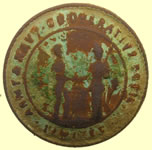 |
 |
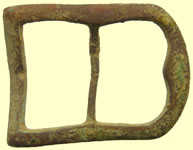 |
 |
||||||
| 1886- 1888 Army & Navy Co-operative Society button | Georgian watch winder | Cast asymmetrical buckle frame with a narrowed pin bar Circa AD 1575 -1700 |
Interesting copper mount with crest - crown even looks like a mitre | ||||||
 |
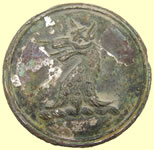 |
 |
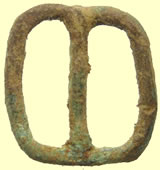 |
||||||
| Glasgow Corporation Transport button | 19thC livery button | Georgian Royal Engineers button | Post Medieval cast copper alloy single loop buckle frame. 1500-1650 AD |
||||||
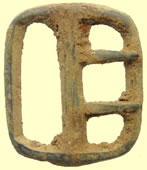 |
 |
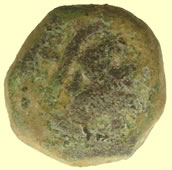 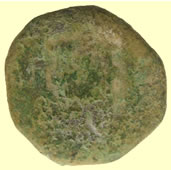 |
|||||||
| 1720-1790 Boot or Garter buckles | 1500-1700 mount with 4 integral lugs | Crude coin weight with lion facing right with long tail - not in my ref books | |||||||
 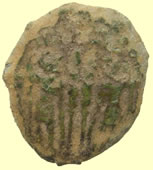 |
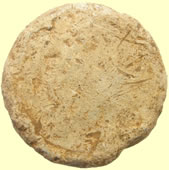 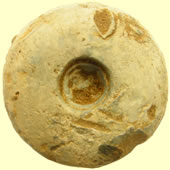 |
||||||||
| Mid 4thC House of Constantine Roman bronze coin - two soldioers standing | Post medieval lead trade weight | ||||||||
Romano/British figurine ?? 9.77g 43.29mm L
|
|||||||||
Back in 2003 the guys found our first Celtic gold and silver hoard and from that field a guy found this little statue which was ID'd by the museum as middle Eastern 17thC I felt it was earlier but took the experts opinion which is why I remember it so clearly . However another exact copy of the same statue was just found on the same spot as the latest Celtic gold hoard and that is too much of a coincidence. I will resend it off to the museum to see if there views have now altered. As it feels more Romano/British than middle eastern. |
|||||||||
  |
 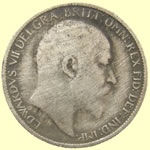 |
||||||||
| Georgian horse harness fitting | 1907 Edward VII milled silver sixpence | ||||||||
 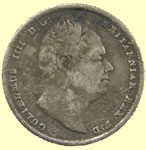 |
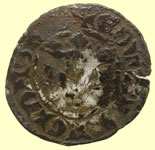 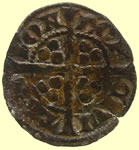 |
||||||||
| 1836 William IV milled silver sixpence | Very unusual hard brown crust on the hammered penny that needs a really good 'cook' to remove 1344 Edward III hammered silver penny - Florin issue - Cross 3 Obv EDWAR ANGL DNS HYB Rev CIV/TAS/LON/DON- London mint |
||||||||
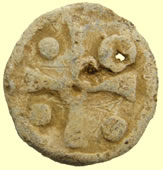 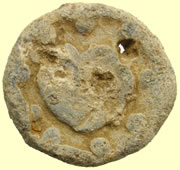 |
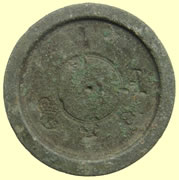 |
 |
|||||||
| Medieval lead trade weight with suspension hole | George III trade weight - Crown G cipher | Medieval beehive thimble | |||||||
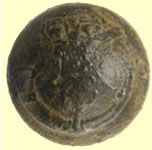 |
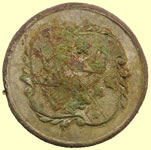 |
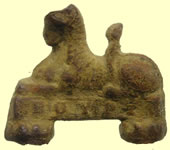 |
 |
||||||
| 19thC Rifle regiment button | 19thC livery button | Eseex Regiment badge | 18thC clog fastener | ||||||
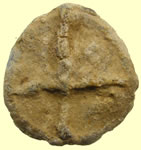 |
 |
 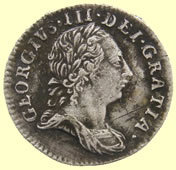 |
|||||||
| 15thC lead token - type 2 | Royal marines Military badge
|
1762 George III milled silver three pence | |||||||
 |
 |
 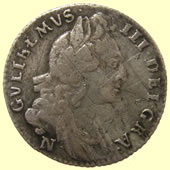 |
|||||||
| WWII Royal Artillery badge | Georgian spur | 1697 William III milled silver sixpence - Norwich mint | |||||||
 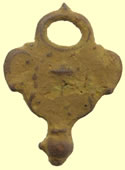 |
 |
||||||||
| Georgian watch winders | Medieval single armed purse bar | ||||||||
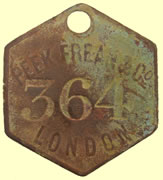 |
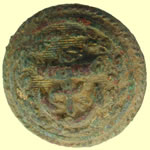 |
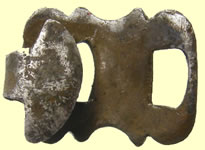 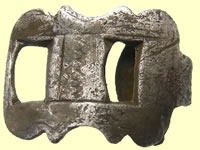 |
|||||||
| Victorian Peek Frean biscuits tag | 1900's Generic merchant navy button | 18thC silver clog fastner | |||||||
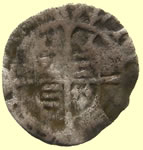 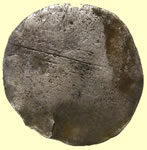 |
 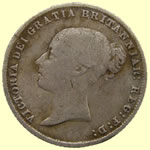 |
||||||||
| 1580-1 Elizabeth hammered silver penny - Pheon mint mark | 1866 Victoria milled silver sixpence | ||||||||
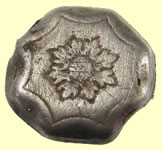 |
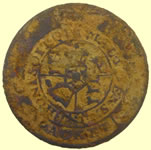 |
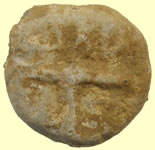 |
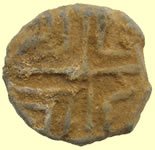 |
||||||
| 18thC silver navy button | One piece Navy buttons HONI SOIT QUI MAN Y PENSE PACKET Honi soit qui mal y pense (Old French: shame upon him who thinks evil of it) RN - Packet Service c.1800-1811 |
15thC lead token | 15thC lead token | ||||||
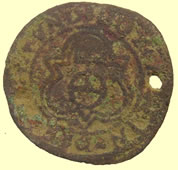 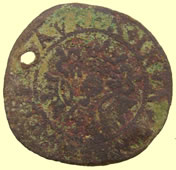 |
  |
||||||||
1586 Hans Krauwincel II Rose orb Jetton HANNS KRAVWINCKEL IN NVRENB |
1819 George III milled silver sixpence | ||||||||
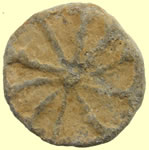 |
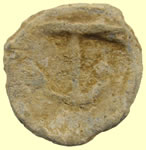 |
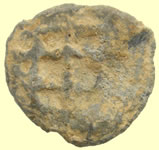 |
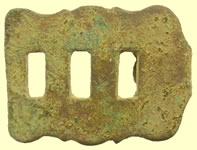 |
||||||
| 17thC lead token | 17thC lead token | 17thC lead token | 18thC clog fastner | ||||||
 |
 |
 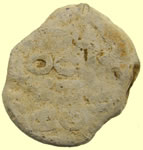 |
|||||||
| Unknown miltary button | Capt / Commander - 1774-1787 |
1808 Russian lead bale seal | |||||||
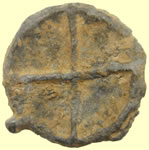 |
 |
 |
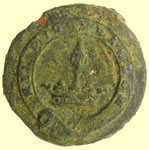 |
||||||
| 15thC lead token | 19thC livery button |
|
19thC livery button | ||||||
 |
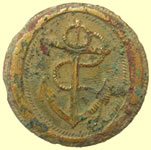 |
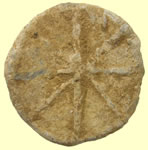 |
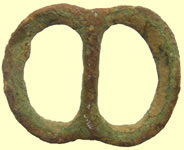 |
||||||
| Young peoples union badge | RN Capt / Commander - 1787 RN Lieutenant - 1787 |
17thC lead token | Post Medieval cast copper alloy single loop buckle frame. 1500-1650 AD |
||||||
 |
|||||||||

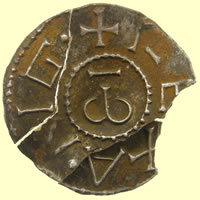
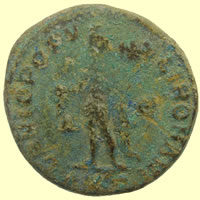
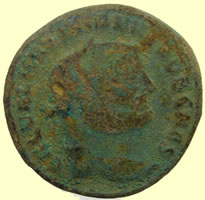


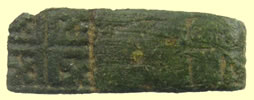

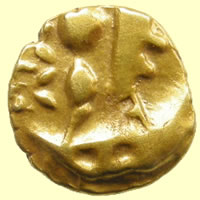
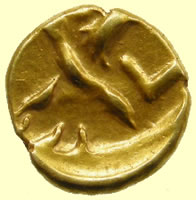
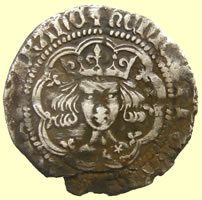
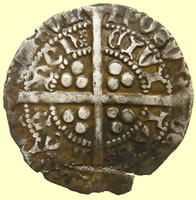

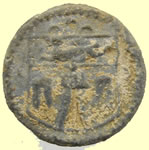
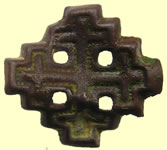
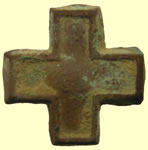
 'A badge for a Knight of the Order of the Holy Sepulchre in bronze and dating somewhere around C13/14th possibly very slightly later . This is a very scarce item and it relates to The Equestrian Order of the Holy Sepulchre of Jerusalem being a Catholic chivalric order of Knighthood that traces its roots to Godfrey of Bouillon, principal leader of the First Crusade. According to reliable sources in the Vatican and Jerusalem, it began in historical reality as a mixed clerical and lay confraternity (association) of pilgrims which gradually grew around the most central of the Christian holy places in the Middle East, the Holy Sepulchre or the tomb of Jesus Christ.This would have been a pin for a member of the order , there is a mark on the reverse where the original pin would have been fixed '
'A badge for a Knight of the Order of the Holy Sepulchre in bronze and dating somewhere around C13/14th possibly very slightly later . This is a very scarce item and it relates to The Equestrian Order of the Holy Sepulchre of Jerusalem being a Catholic chivalric order of Knighthood that traces its roots to Godfrey of Bouillon, principal leader of the First Crusade. According to reliable sources in the Vatican and Jerusalem, it began in historical reality as a mixed clerical and lay confraternity (association) of pilgrims which gradually grew around the most central of the Christian holy places in the Middle East, the Holy Sepulchre or the tomb of Jesus Christ.This would have been a pin for a member of the order , there is a mark on the reverse where the original pin would have been fixed '